For me at least Peregrine Falcons are usually unapproachable but occasionally when they’ve had prey I’ve been able to get close enough for quality photos. That’s why I appreciate the sacrifice of this American Coot.
Most of these images are new to my blog but I’ve posted photo #5 previously.
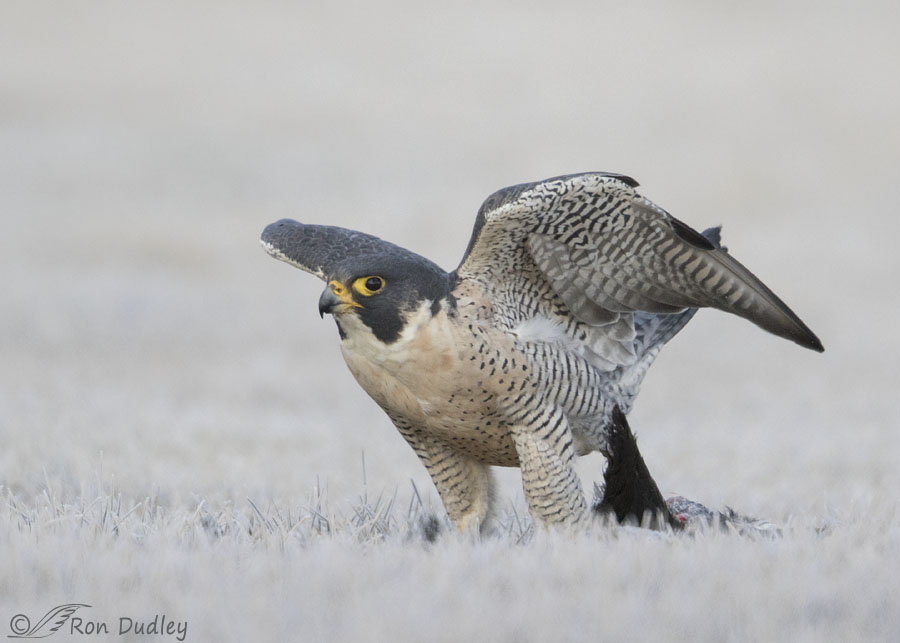
1/1250, f/5.6, ISO 1250, Canon 7D Mark II, Canon EF 500mm f/4L IS II USM + EF 1.4 III Extender, not baited, set up or called in
We found this presumed female (based largely on size) last January in a local park. It wasn’t long after the sun had come up over the nearby mountains but there was heavy cloud cover so the lighting conditions were atrocious, especially at first. I watched her walk quite a distance across the heavily frosted grass and I wondered what her destination was until it soon became apparent that she was walking toward a frozen and partially consumed coot that she’d apparently killed the previous evening. The detached wing of the coot can be seen sticking up out of the grass behind her left leg.
Here she was considering taking off but she changed her mind…
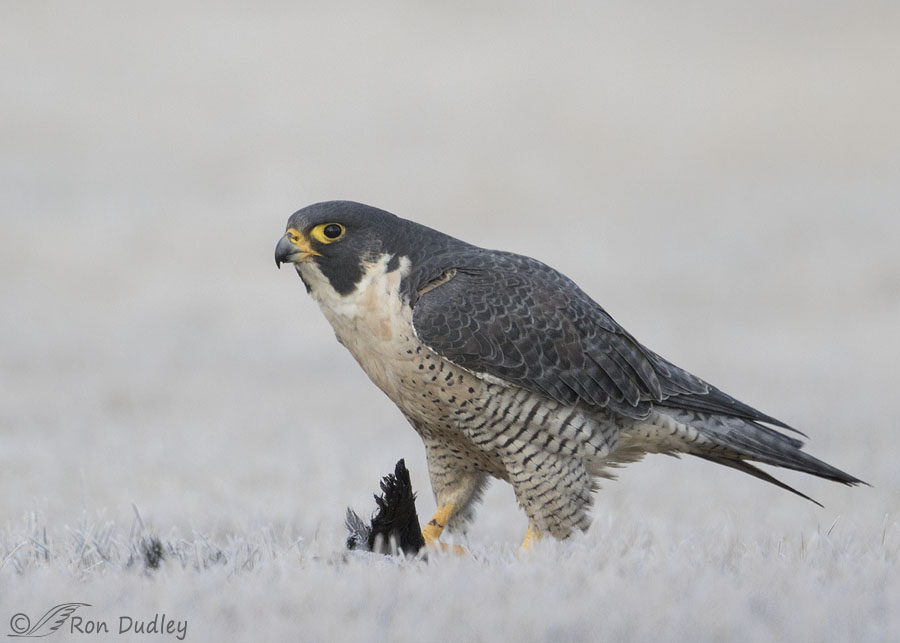
1/1250, f/5.6, ISO 1250, Canon 7D Mark II, Canon EF 500mm f/4L IS II USM + EF 1.4 III Extender, not baited, set up or called in
and turned her attention to the coot’s wing. She stood over it for a while before she…
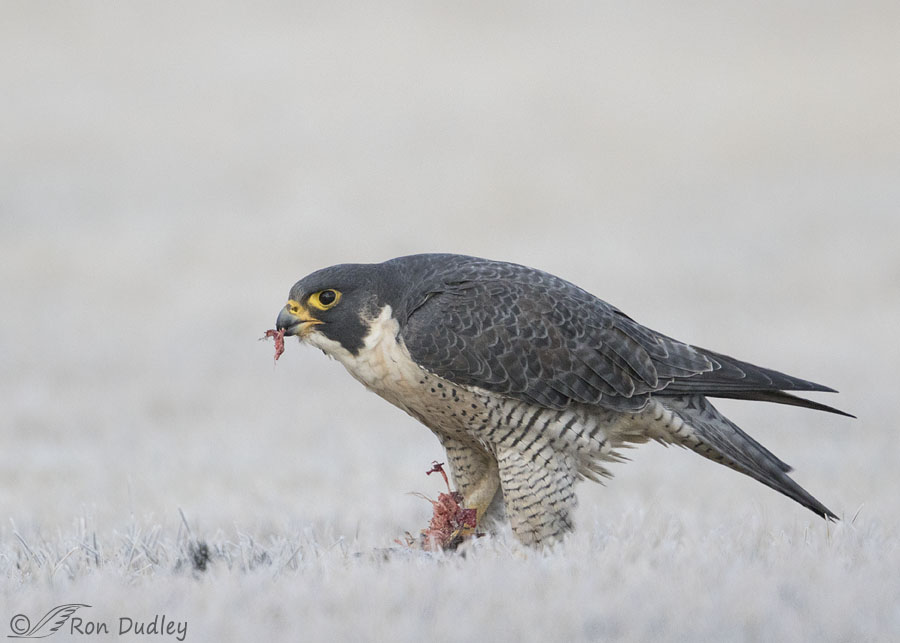
1/2000, f/5.6, ISO 1250, Canon 7D Mark II, Canon EF 500mm f/4L IS II USM + EF 1.4 III Extender, not baited, set up or called in
walked a short distance to the rest of the carcass and began to enjoy her breakfast. But for the entire time she was eating she seemed concerned about the wing in front of her (maybe she thought I might abscond with it…) so she…
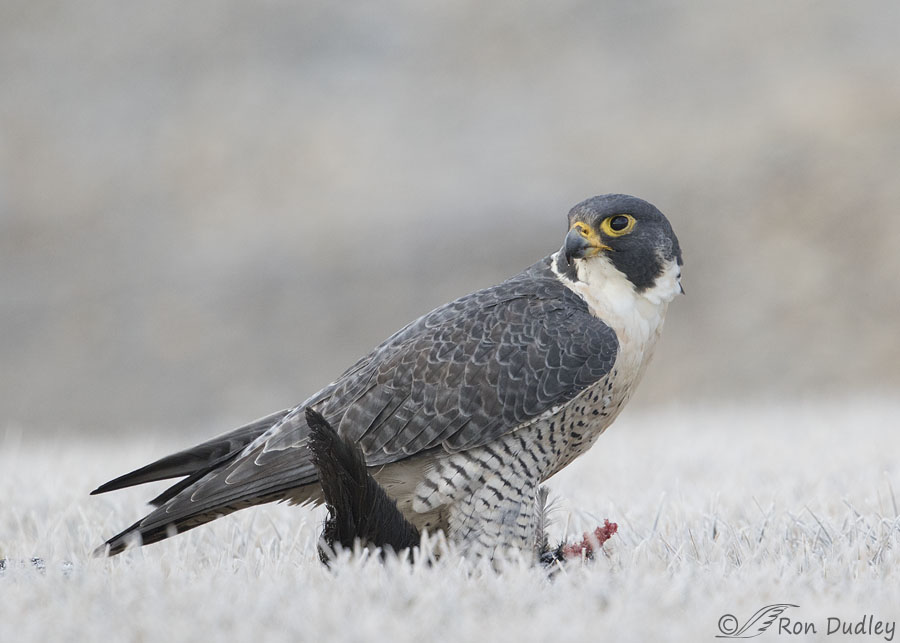
1/640, f/6.3, ISO 1250, Canon 7D Mark II, Canon EF 500mm f/4L IS II USM + EF 1.4 III Extender, not baited, set up or called in
eventually pulled it nearer to the carcass which reunited what was left of the coot with its wing. I think she has a noble look here and in my opinion the wedge-shaped wing adds an interesting graphic dimension.
One lesson I’ve learned over the years is that when a raptor’s enthusiasm for its meal diminishes, as eventually happened with her, and it begins to look around the landscape it’s often about to take off. I was too close optically to avoid clipping body parts if that happened so I quickly removed my teleconverter and I’m glad I did.
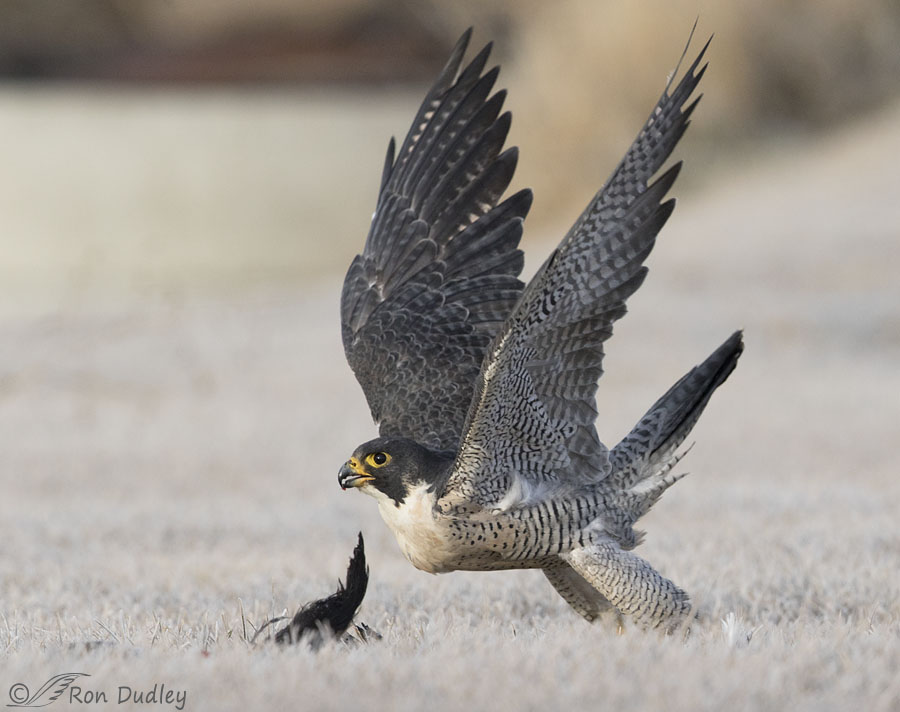
1/2000, f/6.3, ISO 1000, Canon 7D Mark II, Canon EF 500mm f/4L IS II USM, not baited, set up or called in
By then the light had improved a little so with the tc off I had enough shutter speed to get her sharp and enough room in the frame to avoid cutting off body parts. I love her push-off posture and her wing position and I even like the remnant of the coot’s wing because it helps to tell the story of the image. And the open beak allows us to see the falcon tooth (tomial tooth) if we look closely.
Ok, time to fess up. Here’s the real story of why I chose to make a Peregrine Falcon the focus of today’s post. There’s a new documentary from NOVA on PBS called “The World’s Fastest Animal” and based on the title you know it has to be about the Peregrine Falcon.
I watched it two nights ago and I think it’s excellent so I thought many of my readers might like to see it. If you’ve ever had any doubts about the devotion of falconers to their birds, or their enthusiasm for what they do, just wait till you meet crazy Englishman and falconer Lloyd Buck! But the stars of the show are Moses and Rudy, two captive Peregrines that Lloyd puts through their paces as the three of them demonstrate the learning process of training falconry birds and their incredible speed and hunting skills.
Even though I have mixed feelings about falconry I enjoyed the hell out of this program.
Here’s the link on my local PBS station. I watched it online but it can also be seen directly on your local PBS station and it isn’t scheduled to “expire” online until 12/19/18. If you watch it I hope you enjoy it as much as I did. I believe you will.
Ron


Magnificent Ron!
Charlotte
I have the good fortune to have a Gilbert Maggioni 1969 carving of a Peregtine having taken an American Wedgeon.
I would be pleased to send you pictures of it.
Leard Huggins
Leard34@aol.com
912-655-0303
I loved the Nova show and thought about you when I watched it. My television watching is primarily PBS and most likely the wildlife shows. I also watch some bird cams and have really enjoyed doing so. Your pictures are beautiful and I so enjoy your work Thank you for sharing.
“My television watching is primarily PBS”
Me too, Betty. Although I do watch some of their other shows too. Thank you.
Ok this is the second day your post has made me boot up my dying computer. My iPhone just will not work for these posts! I love the lift off shot!
We had an injured Peregrin come from Wheeler Farm, when it was ready for release we let it go in the parking lot of the farm. It makes me happy they are striving to find habitat within the spread of humanity.
Yes, I did watch the PBS show, it was delightful. Their household is a bit like ours, you never know what might be swimming in our tub, spending the night in the shower or perching on a rafter. Our cat will never forgive us for the Tundra Swan on Christmas eve. She thought it was a dragon.
“Our cat will never forgive us for the Tundra Swan on Christmas eve. She thought it was a dragon”
Now that’s a unique comment, April! Made me laugh.
We watched the program last night. Excellent in all ways. Amazing videography that shows the peregrine in slow motion as well as showing the speed of the stoop (150 mph!) I was surprised at the bond between the falconer and his bird.
“the speed of the stoop (150 mph!”
And if need be they can go even faster than that!
Rights restrictions mean that the video is unavailable to me.
Loved your photo series though. And the majesty of the Peregrine Falcon. The frost was wonderful too.
Dang, that’s too bad, EC. Hopefully it will be available in Oz sometime soon.
Video is a WOW! Purely amazing what they can do!
Purely amazing what they can do! 
I agree on both counts, Judy.
Beautiful images. The Peregrine Falcon should be your mascot, what with all your ramblings to produce alll your fantastic photos (certainly not a reference to your always interesting posts!)
Ha, If I remember correctly peregrine means “wanderer” or “nomad”. You obviously know that, Lyle.
While Red-tails will always be my first love among raptors, I have to admit that I am quite enthralled by Peregrine falcons, especially having been able to watch a gorgeous mated pair raise two young — and then continue their relationship — via Explore’s Anacapa Island (CA) webcam this past year. Your photos are wonderful, and I love the ready-for-take-off shot, those outstretched wings and finely-feathered body and legs all on view. Built for speed, indeed! All birds are amazing but I can never get enough of raptors! I will definitely be watching the NOVA program when I get home tomorrow.
I hope you enjoy it, Chris. I’m confident you will. Thank you.
Just by the title, I had a feeling that this wasn’t going to end well for the Coot. A Falcon’s gotta eat, right? She’s a beautiful specimen! The takeoff shot shows off what looks to be a full crop and those lovely pantaloons! Kudos to you for the foresight to take off the tc in time!
Yes, that crop is obviously full, Marty. She actually had to squat far down and then push off in order to take off.
Spectacular shots! Beautiful bird, thanks for sharing!
Thanks, Vira.
Ooh thank you for that link. I believe we have peregrines around here. I keep seeing a bird that looks like this one. It has a very V-shaped pattern when it flies.
I believe we have peregrines around here. I keep seeing a bird that looks like this one. It has a very V-shaped pattern when it flies.
I hope your birds turn out to be peregrines, Arwen. I’m sure that would be fun for you.
LOVED this spectacular series of shots. You’ve captured every inch of its beauty and the frosty grass reminds me of carpet – very interesting setting! Thanks again for sharing.
There was more frost on that grass than I’d seen in a while, Donna. Or since. Thanks.
Thank you for sharing the link to this NOVA programme! This looks amazing!
It is, Andrea.
Gorgeous! Interesting that she was worried about the wing being stolen by someone/something
Interesting that she was worried about the wing being stolen by someone/something  I’ll be pulling the link up to watch since we don’t pull a local PBS station…..
I’ll be pulling the link up to watch since we don’t pull a local PBS station….. 
Judy, Most of my TV watching is done on the computer, generally I actually prefer it.
Excellent shots, and as you know I tried my hand at it. Peregrine’s need time and dedication by their handlers/falconers, not a sport one goes into lightly.
I am going to record this show, many thanks for letting us know about it.
I think it’s worth watching more than once. I know I will. Thanks, Dick.
Outstanding shots of a very beautiful bird! I love being able to see the legs on her. I agree the Peregrine is one of natures noblest looking creatures..at least in my humble opinion…Thank you again Ron for a nice beginning to my day..
Yes, their upper legs are beautiful. Thanks, Steve.
Beautiful shots Ron of one of my favorites. Poor coots are very expendable especially if nothing more appetizing is available. I have been taking photos of a two year old juvenile Peregrine down at one of our close by lakes who also occasionally sits on a high power line pole close to my house. I don’t think I have ever seen that Nova program – will check it out. Thanks.
Everett Sanborn, Prescott AZ
There’s lots of coots in a nearby pond so I’m sure they were the attraction for the falcon, Everett.
I believe it’s a new program and only came out this week.
These are such a beautiful bird; their colors are just striking. I just love the fourth photo especially…that far off gaze is beautiful. That particular photo with that gaze shows off all the detail so well …the blue-grey of the wings and back, the white striping, the beautiful hood. Birds of prey just seem to have it all. I know it’s my imagination but the eyes of these birds always seem a bit larger in proportion… probably because of the yellow ring setting them off.
the fourth photo especially…that far off gaze is beautiful. That particular photo with that gaze shows off all the detail so well …the blue-grey of the wings and back, the white striping, the beautiful hood. Birds of prey just seem to have it all. I know it’s my imagination but the eyes of these birds always seem a bit larger in proportion… probably because of the yellow ring setting them off.
I agree about that fourth photo, Kathy. By then the light was beginning to improve and it made a big difference. I just love that pensive look of the falcon.
Thanks Ron!
What an amazing bird! Like you, I was fascinated by that episode of Nova, particularly the scenes where they tested the vision limits of the captive bird. Wow! Thanks for sharing this today!
Gail
Thanks, Gail. I’m glad you enjoyed that program. Yes, the results of that vision test were very impressive!